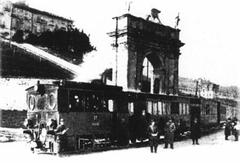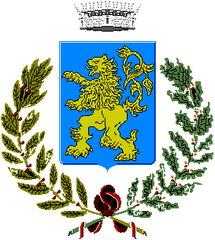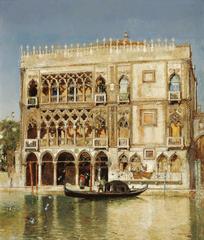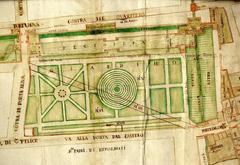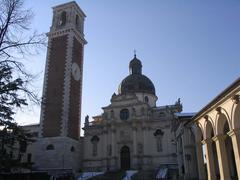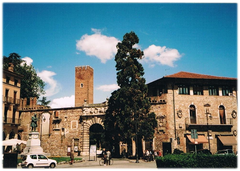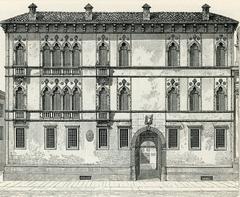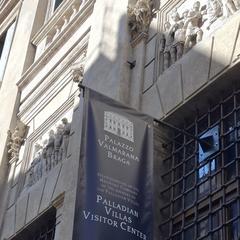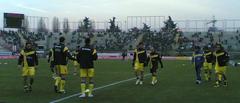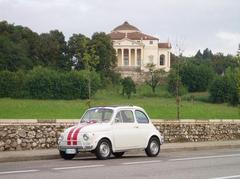Comprehensive Guide to Visiting Cattedrale di Santa Maria Annunciata in Vicenza, Italy
Date: 23/07/2024
Introduction
The Cattedrale di Santa Maria Annunciata, also known as the Vicenza Cathedral, is a monumental testament to the rich history and culture of Vicenza, Italy. Situated in the bustling Piazza Duomo, this architectural marvel has witnessed centuries of transformation, from its humble beginnings in the early Christian period to its current grandeur (Vicenza Cathedral). Renowned architect Andrea Palladio played a crucial role in the Renaissance redesign, adding classical elements that harmonize with the Gothic structure (UNESCO). Beyond its architectural significance, the cathedral is a vital religious center, serving as the seat of the Diocese of Vicenza and a repository of artistic treasures. This comprehensive guide aims to provide all the information you need to make the most of your visit, from historical context and architectural highlights to practical visitor tips and nearby attractions.
Table of Contents
- Introduction
- History of Cattedrale di Santa Maria Annunciata
- Cultural and Religious Significance
- Architectural Highlights
- Visitor Information
- FAQ
- Conclusion
History of Cattedrale di Santa Maria Annunciata
Origins and Early Development
The origins of the cathedral date back to the early Christian period, with the first church on this site believed to have been constructed in the 4th century. This early structure was likely a modest building, reflecting the nascent Christian community in the region.
Romanesque and Gothic Transformations
The cathedral underwent significant transformations during the Romanesque period, around the 11th and 12th centuries. This era saw the construction of a more substantial and ornate structure, characterized by the robust and solid architectural style typical of Romanesque churches. The Gothic period in the 13th century brought further expansion, including the addition of pointed arches, ribbed vaults, and large stained glass windows, which allowed more light to flood into the interior. The Gothic period also saw the construction of the cathedral’s bell tower, which became a prominent feature of Vicenza’s skyline.
Renaissance Rebuilding
The most significant transformation of the Cattedrale di Santa Maria Annunciata occurred during the Renaissance, particularly in the 15th and 16th centuries. This period was marked by the influence of the renowned architect Andrea Palladio, who played a crucial role in the cathedral’s redesign. Palladio’s contributions included the design of the cathedral’s façade, which features a harmonious blend of classical elements such as columns, pilasters, and pediments. The interior was also redesigned to reflect the Renaissance ideals of symmetry and balance.
Baroque and Neoclassical Additions
The 17th and 18th centuries saw further modifications to the cathedral, reflecting the Baroque and Neoclassical styles that were popular during these periods. The Baroque period brought a sense of drama and grandeur to the cathedral’s interior, with elaborate stucco decorations, frescoes, and altarpieces. The Neoclassical renovation in the 19th century aimed to restore and preserve its historical elements while incorporating modern architectural techniques.
Modern Restorations and Preservation
The 20th and 21st centuries have been marked by ongoing efforts to preserve and restore the Cattedrale di Santa Maria Annunciata. These efforts have included structural repairs, cleaning and conservation of artworks, and the installation of modern amenities to accommodate the needs of contemporary visitors. Significant restoration work took place after World War II to repair damage from bombing raids.
Cultural and Religious Significance
The Cattedrale di Santa Maria Annunciata holds immense cultural and religious significance for the city of Vicenza and its inhabitants. As the seat of the Diocese of Vicenza, the cathedral has been a center of religious life and community activities for centuries. It houses numerous artworks and artifacts that reflect the rich history and artistic traditions of Vicenza, including frescoes by Giovanni Antonio Fasolo and sculptures by Orazio Marinali.
Architectural Highlights
The Façade
Designed by Andrea Palladio, the façade is a masterpiece of Renaissance architecture, featuring classical elements such as columns, pilasters, and pediments. The façade’s harmonious proportions and elegant design reflect Palladio’s architectural genius.
The Bell Tower
The cathedral’s bell tower, which dates back to the Gothic period, is a prominent feature of Vicenza’s skyline. The tower’s height and intricate design make it a notable landmark in the city.
The High Altar
The Baroque high altar is a stunning example of 17th-century craftsmanship, featuring intricate carvings, gilded details, and a central altarpiece depicting the Annunciation.
The Frescoes
The cathedral’s interior is adorned with numerous frescoes, including works by Giovanni Antonio Fasolo and other renowned artists. These frescoes depict scenes from the Bible and the lives of saints, adding to the cathedral’s spiritual and artistic ambiance.
Visitor Information
Visiting Hours and Ticket Prices
The cathedral is open to the public every day. Opening hours are typically from 9 AM to 6 PM, but it’s advisable to check the official website of the Diocese of Vicenza for up-to-date information. Entry to the cathedral is free, but donations are welcome.
Guided Tours and Special Events
Guided tours are available and can provide deeper insights into the cathedral’s history, architecture, and artworks. Special events, such as concerts and religious ceremonies, are held periodically. Check the cathedral’s website for information on upcoming events.
Travel Tips and Nearby Attractions
Vicenza is a city rich in history and culture. Nearby attractions include the Teatro Olimpico, Villa La Rotonda, and the Basilica Palladiana. Public transport is readily available, and the city is easily navigable on foot.
Accessibility and Amenities
The cathedral is accessible to visitors with disabilities, with ramps and designated seating areas. Modern amenities, including restrooms and a gift shop, are available on-site.
FAQ
Q: What are the visiting hours for the Cattedrale di Santa Maria Annunciata? A: The cathedral is typically open from 9 AM to 6 PM. Check the official website for current hours.
Q: Is there an entry fee for the cathedral? A: Entry is free, but donations are appreciated.
Q: Are guided tours available? A: Yes, guided tours are available and can be booked through the cathedral’s website.
Q: What are some nearby attractions? A: Nearby attractions include the Teatro Olimpico, Villa La Rotonda, and the Basilica Palladiana.
Conclusion
The Cattedrale di Santa Maria Annunciata is not just a historical monument but a living testament to the rich cultural and religious heritage of Vicenza. Whether you’re an architecture enthusiast, a history buff, or a spiritual seeker, a visit to this magnificent cathedral offers an enriching experience. For more detailed information, guided tours, and updates on special events, visit the official website of the Diocese of Vicenza. Don’t forget to explore nearby attractions like the Teatro Olimpico and Basilica Palladiana to fully immerse yourself in the historical and cultural richness of Vicenza.
References
- Complete Guide to Visiting Cattedrale di Santa Maria Annunciata in Vicenza - History, Tickets, and More, 2024 diocesivicenza.it
- City of Vicenza and the Palladian Villas of the Veneto, UNESCO, 2024 whc.unesco.org
